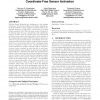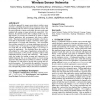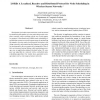346 search results - page 16 / 70 » Redundant Coverage in Wireless Sensor Networks |
MOBICOM
2009
ACM
14 years 2 months ago
2009
ACM
Wireless Sensor Networks are emerging as a key sensing technology, with diverse military and civilian applications. In these networks, a large number of sensors perform distribute...
SENSYS
2003
ACM
14 years 1 months ago
2003
ACM
An effective approach for energy conservation in wireless sensor networks is scheduling sleep intervals for extraneous nodes, while the remaining nodes stay active to provide cont...
MSN
2007
Springer
14 years 2 months ago
2007
Springer
Success of Wireless Sensor Networks largely depends whether the deployed network can provide desired coverage with acceptable network lifetime. This paper proposes a distributed pr...
DATE
2005
IEEE
2005
IEEE
LORD: A Localized, Reactive and Distributed Protocol for Node Scheduling in Wireless Sensor Networks
13 years 9 months ago
The lifetime of wireless sensor networks can be increased by minimizing the number of active nodes that provide complete coverage, while switching off the rest. In this paper, we ...
ICCCN
2007
IEEE
14 years 2 months ago
2007
IEEE
Abstract— With the rapid deployment of wireless sensor networks, there are several new sensing applications with specific requirements. Specifically, target tracking applicatio...



